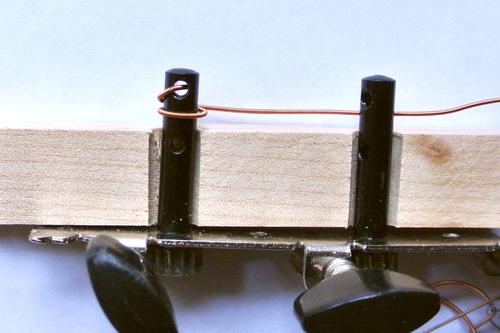 The root of the problem is that there is nothing to support the tuner's
sound post against the sideways pull from the strings.
This results in a lot of leverage applied where the sound post
goes through the sheet metal.
The root of the problem is that there is nothing to support the tuner's
sound post against the sideways pull from the strings.
This results in a lot of leverage applied where the sound post
goes through the sheet metal.
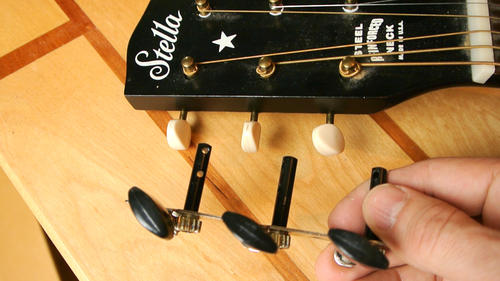 Since building a ukulele I have taken a bit of interest
in guitars and bought several cheap ones in various states at yard sales.
Since building a ukulele I have taken a bit of interest
in guitars and bought several cheap ones in various states at yard sales.
What they have in common is cheap tuners that can be inconsistent and hard to turn.
 The root of the problem is that there is nothing to support the tuner's
sound post against the sideways pull from the strings.
This results in a lot of leverage applied where the sound post
goes through the sheet metal.
The root of the problem is that there is nothing to support the tuner's
sound post against the sideways pull from the strings.
This results in a lot of leverage applied where the sound post
goes through the sheet metal.
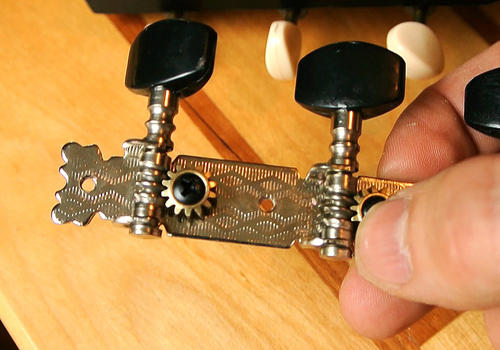 This leverage pushes the worm gears together, and as the gears engage tooth
to tooth, wiggle the sound post slightly, causing the tuning to jump unexpectedly.
This leverage pushes the worm gears together, and as the gears engage tooth
to tooth, wiggle the sound post slightly, causing the tuning to jump unexpectedly.
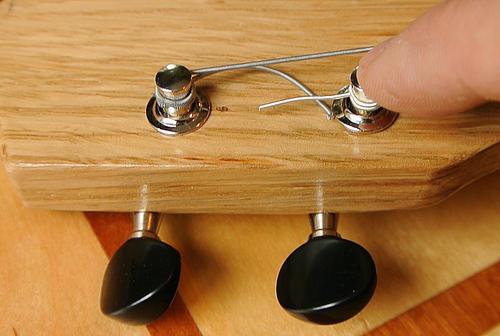 The tuners on my homemade ukulele are nearly the same design, but they came with
sleeves, or bushings to install in the head
(see here). These steady the posts, so
they work very smoothly.
The tuners on my homemade ukulele are nearly the same design, but they came with
sleeves, or bushings to install in the head
(see here). These steady the posts, so
they work very smoothly.
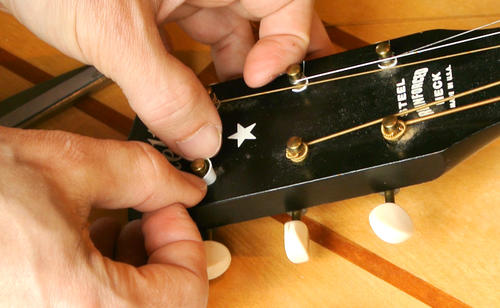 Not having any suitable bushings for the tuners on my cheap guitar,
I cut some shims out of a plastic cream cheese container lid,
bent them into an arch, and pushed them into the space around
the post.
Not having any suitable bushings for the tuners on my cheap guitar,
I cut some shims out of a plastic cream cheese container lid,
bent them into an arch, and pushed them into the space around
the post.
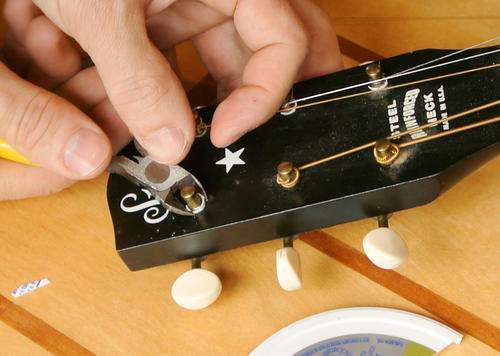 I always ended slightly folding and bending the edge as I inserted it, so I'm using
a pair of snippers to crimp and cut the part that I couldn't force into the hole.
I always ended slightly folding and bending the edge as I inserted it, so I'm using
a pair of snippers to crimp and cut the part that I couldn't force into the hole.
In retrospect, if I used some black plastic, that wouldn't show up as much.
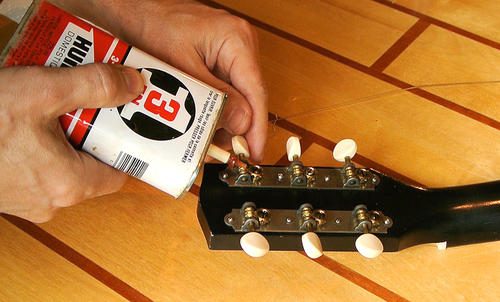 Before putting the strings back on, it helps to oil the tuners. It's best
to use a relatively thick oil. Axle grease would be best, if you have any.
Don't use WD40 — it evaporates over time.
After turning the tuners for a few turns, wipe off the excess oil.
Before putting the strings back on, it helps to oil the tuners. It's best
to use a relatively thick oil. Axle grease would be best, if you have any.
Don't use WD40 — it evaporates over time.
After turning the tuners for a few turns, wipe off the excess oil.
With these modifications, this guitar became MUCH easier to tune.
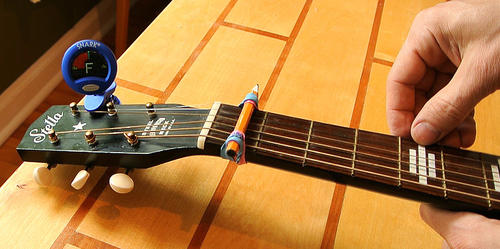 Another modification I came up with related to my fingers getting sore
from the steel strings.
Another modification I came up with related to my fingers getting sore
from the steel strings.
If the strings are closer to the frets (lower action), they don't need to
be pressed as hard. I found they are closer to subsequent frets on this cheap
guitar if I clamp then down above the first fret. A "capo" type clamp would
be ideal, but I don't have one. A short pencil and some sturdy rubber bands
will also do the trick.
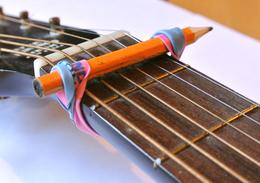
Of course, this causes the instrument to plays one semitone too high. So I then tuned the guitar down by one semitone to compensate. Tuning it down by a semitone reduces the string tension by 12%, which also makes it easier to push down on the stings.
If you practice the guitar a lot, you eventually develop calluses your finger tips, and the steel strings won't be painful anymore, but I think this is a good trick when starting out. I don't intend to practice that much.
If you are buying a new guitar, I'd recommend a good quality nylon string classical guitar. The action on a quality guitar will be lower (strings closer to the fretboard), and nylon strings are thicker and have less tension. Classical guitars also have a wider fretboard.
But in the mean time, I like playing around with my $10 yard sale guitar. If I spent $200 to buy something decent, I'd feel obliged to actually learn to play it. But at $10 invested, I'm quite comfortable just playing around with it.
See also:
Back to my woodworking website.
![]()